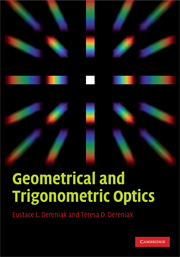Book contents
- Frontmatter
- Contents
- Preface
- 1 Light propagation
- 2 Reflections and refractions at optical surfaces
- 3 Image formation
- 4 Mirrors and prisms
- 5 Curved optical surfaces
- 6 Thin lenses
- 7 Thick lenses
- 8 Mirrors
- 9 Optical apertures
- 10 Paraxial ray tracing
- 11 Aberrations in optical systems
- 12 Real ray tracing
- Appendix A Linear prism dispersion design
- Appendix B Linear mixing model
- Appendix C Nature's optical phenomena
- Appendix D Nomenclature for equations
- Appendix E Fundamental physical constants and trigonometric identities
- Glossary
- Index
- References
5 - Curved optical surfaces
Published online by Cambridge University Press: 06 July 2010
- Frontmatter
- Contents
- Preface
- 1 Light propagation
- 2 Reflections and refractions at optical surfaces
- 3 Image formation
- 4 Mirrors and prisms
- 5 Curved optical surfaces
- 6 Thin lenses
- 7 Thick lenses
- 8 Mirrors
- 9 Optical apertures
- 10 Paraxial ray tracing
- 11 Aberrations in optical systems
- 12 Real ray tracing
- Appendix A Linear prism dispersion design
- Appendix B Linear mixing model
- Appendix C Nature's optical phenomena
- Appendix D Nomenclature for equations
- Appendix E Fundamental physical constants and trigonometric identities
- Glossary
- Index
- References
Summary
Thus far, we have discussed images and objects qualitatively. Other than in the case of the pinhole camera, we have not examined the actual production of the image of an object, but only what we thought the image orientation and its handedness might be. In order to produce an optical image, the rays or optical radiation must converge or diverge upon refraction or reflection. Only surfaces of optical power, or curved optical surfaces, can have this effect on rays. This book focuses on geometrical optics; diffractive optical elements of power will not be discussed. Before discussing the effects of curved optical surfaces on rays, we will digress and cover two very important subjects: optical spaces and the sign convention used in this text.
Optical spaces
The concept of “optical spaces” plays a very important role in the understanding of optical systems as well as in the layout of their design. There are multiple optical spaces in most systems; however, the minimum is three: object space, image space, and lens space, as shown in Figure 5.1. One example of this is the idea of object space, which is defined as the space domain where the object lies in a homogeneous medium which has a given index of refraction. For many systems, this medium is typically air. One can visualize a region from negative infinity to the first glass surface of a lens as being the physical space where an object resides.
- Type
- Chapter
- Information
- Geometrical and Trigonometric Optics , pp. 96 - 121Publisher: Cambridge University PressPrint publication year: 2008



